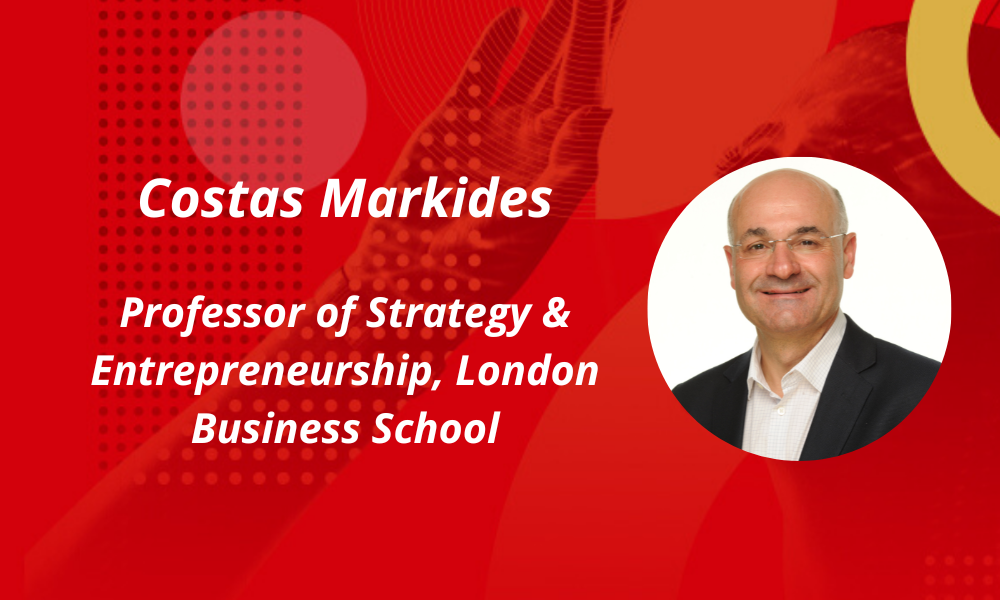Sink or swim: HR must organize for change in response to continuous disruption
- 7 Min Read
Change is ubiquitous, often creating a fresh set of challenges in its wake. Costas Markides, Professor of Strategy & Entrepreneurship at the London Business School, explores how HR can organize for continuous disruption and activate sustainable urgency for change.
- Author: Costas Markides
- Date published: Sep 21, 2022
- Categories

My research over the past five years has found that managerial decision-making on how to respond to disruption is often based on beliefs that are either wrong or half-truths. The implications of this are dire. Starting one’s thinking with a mistaken belief or the wrong attitude will result in strategies and actions that are rarely the right ones. Unsuccessful responses to disruption will, inevitably, follow.
Understanding unsuccessful responses
One of the biggest mistaken beliefs about disruption that has emerged over the past few years is that that it is best to approach disruption as an opportunity rather than a threat. Nothing could be further from the truth!
The doctoral dissertation work of Clark Gilbert at Harvard Business School found that companies that viewed disruption as a threat ended up failing in their response. More surprisingly, he also found that those companies that viewed it as an opportunity similarly failed in their response. It was only the companies that viewed it as both a threat and an opportunity that ended up developing successful response strategies.
Surprising as this finding may be, the rationale behind it is quite simple: viewing something as a threat has both benefits and costs—on the plus side, it helps us develop a sense of urgency in the organisation but on the minus side, it makes us short-term oriented and non-thinking.
Similarly, viewing something as an opportunity also has benefits and costs—on the plus side, it helps us think about the issues logically, analytically and with a long-term perspective; but on the minus side, it fails to create the necessary sense of urgency that leads to action. Thus, to achieve both urgency and long-term thinking, it is best to frame disruption as both a threat and an opportunity.
Whereas the rationale for this is simple enough, the implications of approaching disruption with the “right” attitude are profound. If disruption is both a threat and opportunity, the first implication is that companies need to both defend and attack disruption.
But this immediately raises the question: “Can a company defend and attack with one strategy? Perhaps it is better to have two different strategies—one that aims to protect the core and a second one that aims to exploit the new markets created by disruption? And if two different strategies are needed, can the managers of the core business develop both or should the development of the “attack” strategy be assigned to totally different people? Finally, if two different strategies are needed to “respond” to disruption, should they both be implemented by the same company, or should a separate unit be given the task of executing the attack strategy?
These are obviously difficult questions to answer, and we do not pretend to have all the answers. But the point is that it is only when we start our thinking with the “right” attitude towards disruption that the “correct” questions are being asked.
Producing sustainable urgency for change
A second misconception about disruption that has emerged within business circles is that a firm can create sustainable urgency for change in the organisation by pointing out the serious danger the firm is in (as a result of disruption)—in other words, by trying to create a burning platform or by trying to scare people. Research has shown that this rarely works.
In his book Change or Die, Alan Deutschman reported an alarming statistic: 90% of patients that have undergone coronary-artery bypass surgery and are told by their doctors to change their lifestyle or face the prospect of early death, fail to do so. Even those that change their bad habits in the short term, end up going back to their bad habits within six months of their operations. This suggests that trying to scare people into changing does not work in producing sustainable change—yet how often do companies use the “change or die” rhetoric to rally their employees into action to respond to disruption?
Another interesting insight to emerge from this study was the reason that prompted 10% of patients to actually change. These people were not asked to change to avoid early death; instead, they were given positive reasons for changing — things like being able to play with their grandchildren without feeling pain or being able to take long walks in the park without having to carry an oxygen cylinder with them. But more important than giving them a positive reason to change, was the fact that the reason for change was communicated in an emotional way to them. The key was to make the need for change emotional to them.
Winning emotional commitment is key
This finding has a serious implication on how we can create urgency for change in an organisation. The “wrong” way to do it is by trying to scare people; the “correct” way to do it is by giving people something positive to aim for and then spending all our energy and effort “selling” it to them to win their emotional commitment to it.
What makes the difference is not the “why” we need to change but winning people’s emotional commitment to this “why”. This may explain why so many change programmes fail.
It is easy to come up with a nice-sounding, positive reason why we need to change. But how many organisations spend the time and resources to “sell” this reason to their employees to win not only their rational acceptance but also their emotional commitment to it?
Winning emotional commitment for something is extremely difficult. It is also something than will require us to use not only inspiring speeches and presentations but also additional tactics and strategies. It is hard but this is the only way to create the right kind of urgency in an organisation.
 Costas Markides is Professor of Strategy and Entrepreneurship and holds the Robert P. Bauman Chair of Strategic Leadership at the London Business School (LBS). He has been a professor at LBS since 1990 where he has served as Chairman of the Strategy Department for six years and as member of the Academic Board of Executive Education at the school for four years. He also serves on the Editorial Boards of several academic journals and served on the Board of Directors of the Strategic Management Society (SMS) for 6 years in 2013-2019.
Costas Markides is Professor of Strategy and Entrepreneurship and holds the Robert P. Bauman Chair of Strategic Leadership at the London Business School (LBS). He has been a professor at LBS since 1990 where he has served as Chairman of the Strategy Department for six years and as member of the Academic Board of Executive Education at the school for four years. He also serves on the Editorial Boards of several academic journals and served on the Board of Directors of the Strategic Management Society (SMS) for 6 years in 2013-2019.
A native of Cyprus, he received his BA (Distinction, 1983) and MA (1984) in Economics from Boston University, and his MBA (1985) and Doctorate (1990) from the Harvard Business School. He has published his research in top academic journals as well as top managerial journals. He has also published several books on the topics of strategy and innovation, including the best-selling books:
- All the Right Moves: A guide to Crafting Breakthrough Strategy (1999) that was shortlisted for the Igor Ansoff strategy book of the year award in 2000.
- Fast Second: How smart companies bypass radical innovation to enter and dominate new markets (2004) that was shortlisted for the 2005 Financial Times/Goldman Sachs Management book of the year award.
- Game-Changing Strategies: How to create new market space in established industries by breaking the rules (2008)
- Organizing for the New Normal: Prepare your company for the journey of continuous disruption (2021).
He is currently examining how established firms respond to new business models invading their markets and is writing a new book entitled Business Model Innovation, to be published by Cambridge University Press in late 2022. He is also exploring how we can use the technologies of the social era as well as new and disruptive business models to solve big societal problems, such as poverty, malnutrition, inner-city crime and climate change.









